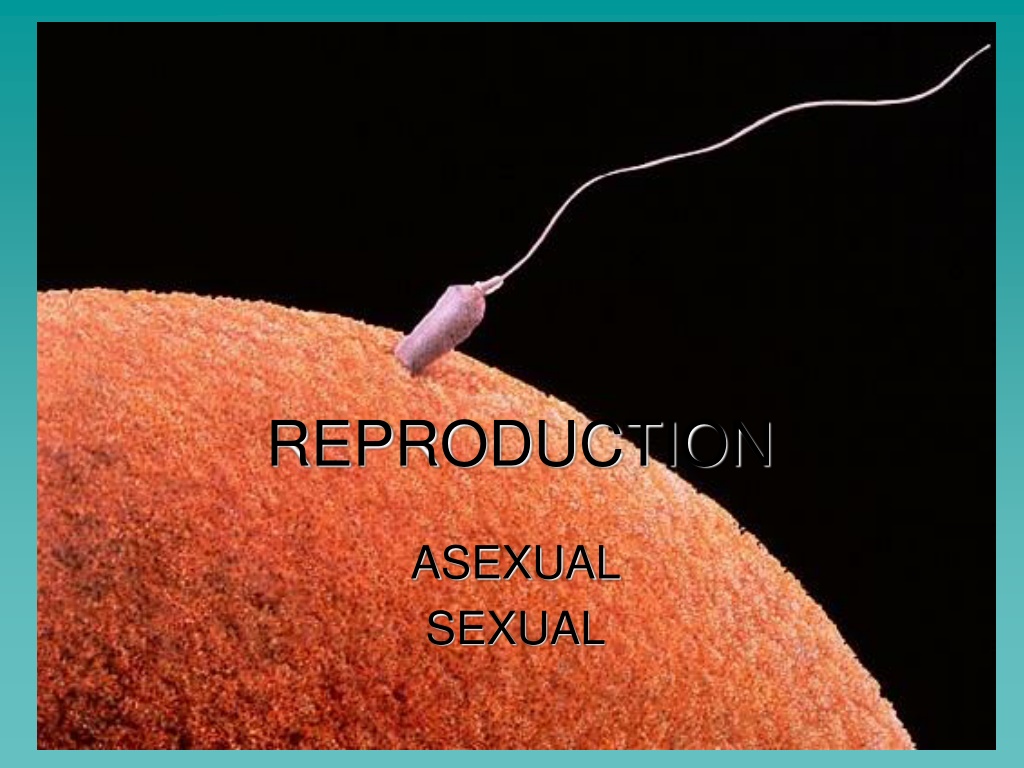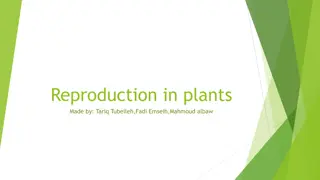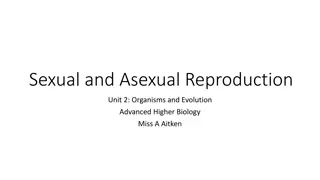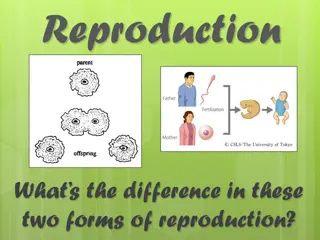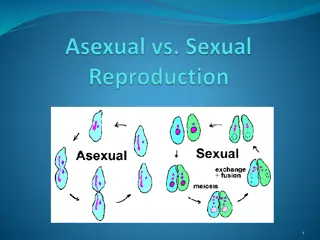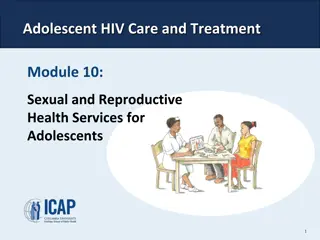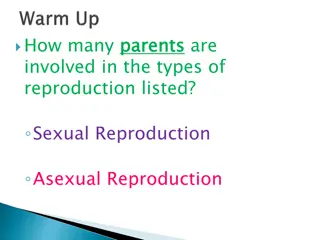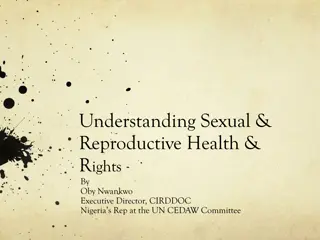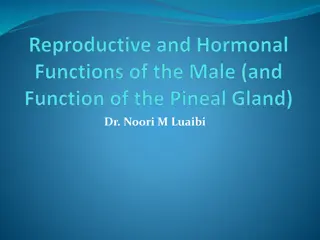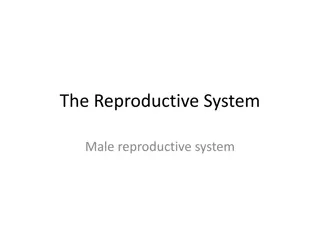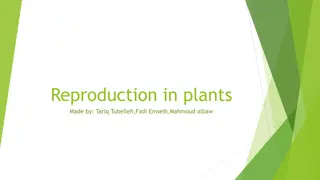Understanding Reproductive Modes: Asexual vs. Sexual
Reproduction can occur through asexual or sexual means, each with its distinct processes and outcomes. Asexual reproduction involves only one parent and produces genetically identical offspring, while sexual reproduction involves the fusion of specialized sex cells from two parents to create genetically diverse offspring. Various forms of asexual reproduction, such as budding, binary fission, and spore formation, are prevalent in different organisms. On the other hand, sexual reproduction involves the production of sex cells, fertilization, and zygote development. Both modes have their advantages and disadvantages, influencing the survival and genetic diversity of species.
Download Presentation

Please find below an Image/Link to download the presentation.
The content on the website is provided AS IS for your information and personal use only. It may not be sold, licensed, or shared on other websites without obtaining consent from the author. Download presentation by click this link. If you encounter any issues during the download, it is possible that the publisher has removed the file from their server.
E N D
Presentation Transcript
REPRODUCTION ASEXUAL SEXUAL
REPRODUCTION ASEXUAL: One parent is involved No fertilisation occurs. No specialised sex cells Cell division occurs via mitosis Offspring are genetically identical to each other & parent (produce clones) Few organisms reproduce asexually Hydra, amoeba, flowering plants, celery & strawberry.
FORMS OF ASEXUAL REPRODUCTION 1) Budding e.g. Hydra 2) Binary fission e.g. Amoeba 3) Vegetative propagation e.g. runners (celery, strawberry) & bulbs (onions) 4) Cuttings sugar cane 5) Grafting e.g. citrus, mango 6) Parthenogenesis occurs in aphids (greenflies).
Parthenogenesis this is where an egg develops w/o being fertilised. Abundant food = production of many eggs Young aphids born fully developed
1. Tentacles 2. Hypostome 3. Buds 4. Foot
Spore Formation It is generally seen in bacteria and most fungi. Example bread mould. One of the cells enlarges and forms the sporangium (literally meaning spore sac). The nucleus divides many times and then the daughter nuclei are surrounded with protoplasm bits to form daughter cells called spores. The spores are covered with a thick wall called the cyst. On maturation, the sporangium bursts and releases the spores. The spores germinate on getting favourable conditions. For example, fungi such as Mucor and Rhizopus Spore formation also occurs in bacteria such as Clostridium and Bacillus. The bacterial spores are also called endospores. They are thick-walled and lightweight
ADVANTAGES & DISADVANTAGES OF ASEXUAL REPRODUCTION See Atwaroo-Ali page 196-7
SEXUAL REPRODUCTION Four key stages in sexual reproduction: 1. Sex cells (sperm & ova) are produced. 2. Male sex cell is transferred to female sex cell. 3. Fertilisation must occur i.e. sperm fuses with ovum. 4. The zygote formed develops into a new individual.
SEXUAL REPRODUCTION Involves 2 parents producing special reproductive cells/gametes (egg & sperm) Gametes fuse = fertilisation = zygote: continues to divide form a new organism Meiosis - hence offspring are different from each other and parents Sex cells/gametes half # of chromosomes thus are different from other cells in the body that make up parts such as organs
Gametes have half # of chromosomes so that when they fuse the zygote formed will have the correct # of chromosomes (e.g. 46 in humans) We have 46 chromosomes in each body cell but 23 chromosomes are present in each egg and sperm. Thus when egg & sperm fuse 2 fertilisation: 23 + 23 = 46 chromosomes The 46 chromosomes are of 23 different kinds and are 2 of each kind.
W.r.t 2 chromosomes of each kind homologous chromosomes. A cell with a full # of chromosomes with 2 of each kind DIPLOID (2n) A cell with half # of chromosomes HAPLOID (n) e.g. egg & sperm Gametes are haploid but form a diploid zygote when they fuse together.
ADVANTAGES & DISADVANTAGES OF SEXUAL REPRODUCTION See Atwaroo-Ali page 197
STRUCTURE OF MALE REPRODUCTIVE SYSTEM
The penis and the urethra are part of the urinary and reproductive systems. The scrotum, testes, vas deferens, and prostate gland comprise the rest of the reproductive system.
The purpose of the organs of the male reproductive system is to perform the following functions: 1. To produce, maintain, and transport sperm (the male reproductive cells) and protective fluid (semen) 2. To discharge sperm within the female reproductive tract during sex 3. To produce and secrete male sex hormones responsible for maintaining the male reproductive system
Unlike the female reproductive system, most of the male reproductive system is located outside of the body. These external structures include the penis, scrotum, and testicles. 1. Penis 2. Scrotum: loose pouch-like sac of skin that hangs behind and below the penis. contains the testicles (also called testes), as well as many nerves and blood vessels.
3. Testicles (testes): Oval organs that lie in the scrotum, secured at either end by a structure called the spermatic cord. The internal organs of the male reproductive system, also called accessory organs, include the following: 1. Epididymis: The epididymis is a long, coiled tube that rests on the backside of each testicle. Transports and stores sperm cells that are produced in the testes.
2. Vas deferens: The vas deferens is a long, muscular tube that travels from the epididymis into the pelvic cavity, to just behind the bladder. 3. Urethra: The urethra is the tube that carries urine from the bladder to outside of the body. 4. Seminal vesicles: The seminal vesicles are sac-like pouches that attach to the vas deferens near the base of the bladder. 5. Prostate gland: The prostate gland is a walnut-sized structure that is located below the urinary bladder in front of the rectum.
How Does the Male Reproductive System Function? Dependent on hormones - follicle-stimulating hormone (FSH), luteinizing hormone (LH), and testosterone. Follicle-stimulating hormone is necessary for sperm production (spermatogenesis) and luteinizing hormone stimulates the production of testosterone, which is also needed to make sperm. Testosterone is responsible for the development of male characteristics, including muscle mass and strength, fat distribution, bone mass, facial hair growth, voice change, and sex drive.
http://lgfl.skoool.co.uk/content/keystage3/biology/pc/lear ningsteps/MRSLC/launch.html STRUCTURE OF SPERM
Sperm cells have three distinct regions, the head, midpiece and tail. Head - an acrosome and a nucleus. Midpiece - packed with mitochondria that break down glucose (present in semen) producing ATP to power the movement of the flagella. The tail is a single flagellum. Source of locomotion.
STRUCTURE OF FEMALE REPRODUCTIVE SYSTEM More complex than male reprod ve system Located in the pelvic region Structures are the ovary, uterine tubes, uterus, vagina, vulva, and mammary glands. It produces ova (egg cells); nourishes, carries, and protects the developing embryo; and nurses the newborn after birth.
The internal genital organs form a pathway (the genital tract). This pathway consists of the following: Vagina (part of the birth canal), where sperm are deposited and from which a baby can emerge Uterus, where an embryo can develop into a fetus Fallopian tubes (oviducts), where a sperm can fertilize an egg Ovaries, which produce and release eggs Sperm can travel up the tract, and eggs down the tract.
Vagina: A narrow, muscular but elastic organ about 4 to 5 inches long in an adult woman. It connects the external genital organs to the uterus. Main female organ of sexual intercourse. Uterus and Cervix: A thick-walled, muscular, pear-shaped organ located in the middle of the pelvis, behind the bladder, and in front of the rectum. Main function is to sustain a developing foetus.
The cervix is the lower part of the uterus, which protrudes into the upper end of the vagina. Fallopian Tubes/oviduct: The two fallopian tubes, which are about 2 to 3 inches (about 5 to 7 centimeters) long, extend from the upper edges of the uterus toward the ovaries. Ovaries: The ovaries are usually pearl-coloured, oblong, and about the size of a walnut. They are attached to the uterus by ligaments
PRODUCTION OF EGGS Eggs are produced from cells in outer layer/epithelium of ovary via cell division. Some cells move towards the centre of ovary. A small space filled with fluid forms around each cell. Space & cell inside follicle. This occurs before a girl is born.
When puberty occurs some follicles begin to develop usually 1 @ a time. The cell inside the follicle grows bigger along with fluid filled space around it. The follicle moves to the edge of ovary Graafian follicle ~ 1 cm across & bulges outside of ovary. cell inside G. follicle undergoes meiosis. Only 1 cell becomes an egg. Follicle bursts & egg is released from ovary (ovulation). This occurs once a month.
http://www.cix.co.uk/~argus/Dreambio/control%20of%20reproductiohttp://www.cix.co.uk/~argus/Dreambio/control%20of%20reproductio n/ova%20production.htm
MENSTRUAL CYCLE http://lgfl.skoool.co.uk/content/keystage3/biology/pc/learningsteps/MEN LC/launch.html There are four major hormones (chemicals that stimulate or regulate the activity of cells or organs) involved in the menstrual cycle: follicle-stimulating hormone, luteinizing hormone, oestrogen, and progesterone. The menstrual cycle is the repeating series of changes in the uterine lining of a fertile female provided fertilisation and implantation does not happen. This cycle ranges from 24 to 35 days, and is commonly 28 days.
Events of the female reproductive cycle: A. Day 1 to day 5 Day 1 is the first day of menstruation. The corpus luteum of the previous cycle has disintegrated so the level of oestrogen and progesterone declined greatly. Low progesterone level leads to the menstruation - breakdown and discharge of the outer layer of the uterine lining. Low oestrogen and progesterone levels permit the secretion of FSH by the pituitary gland.
B. Day 6 to day 13 FSH stimulated the formation of a Graafian follicle. The maturing follicle secretes oestrogen which inhibits FSH secretion preventing other follicles maturing. Oestrogen also stimulates repair of the uterine lining and a surge of LH just before ovulation (Follicular phase). C. Day 14 The surge of LH stimulates ovulation - release of the egg cell from the mature Graafian follicle at the ovary's surface (Ovulatory phase). The egg cell is drawn into the Fallopian tube.
D. Day 15 to day 26 A corpus luteum develops from the remains of the Graafian follicle. The corpus luteum secretes progesterone and oestrogen stimulating the final maturation of the uterine lining (Luteal phase). High levels of these hormones also inhibit FSH and LH secretion from the pituitary. If implantation does not take place by day 26, the corpus luteum disintegrates.
E. Day 26 to day 28 Rapid decline in the levels of progesterone and oestrogen due to the degeneration of the corpus luteum. The first sign that pregnancy has occurred is the failure of menstruation. Implantation occurs about six days after fertilisation. The developing embryo releases a hormone into the mother's blood which maintains the corpus luteum. The surviving corpus luteum continues to secrete progesterone and oestrogen and so the endometrium does not breakdown. Pregnancy ends with the birth of the foetus - on average 38 weeks after fertilization or 40 weeks after the last menstruation.
FERTILISATION http://lgfl.skoool.co.uk/content/keystage3/biology/pc/lear ningsteps/HUFLC/launch.html http://www.britannica.com/EBchecked/topic-art/436140/19665/The- ovaries-in-addition-to-producing-egg-cells-secrete-and See Atwaroo-Ali and Chinnery.
PLACENTA The functions of the placenta : 1. Protection of the embryo: impedes the entry of pathogens from the mother, allows the entry of antibodies from the mother and keeps the embryo separated from the mother's higher blood pressure, prevents exchange of red blood cells avoiding the deadly possibility of agglutination. 2. Gas exchange: supply of O2 the mother and excretion of CO2 from the embryo to the mother's blood. 3. Nutrient supply: glucose, amino acids, lipids, vitamins and minerals pass to the embryo from the mother's blood.
4. Endocrine: secretes a variety of hormones including oestrogen and progesterone to maintain the pregnancy and prepare the mother's body for birth and lactation. 5. Excretion: metabolic wastes, CO2 and urea, pass from embryo into the mother's blood. 6. The placenta is connected to the embryo by the umbilical cord along which run two arteries and a large vein.
Birth or parturition - three major stages: A. Labour: gradual dilation of the cervix to a diameter allowing safe passage of the head into the vagina. Oxytocin hormone is secreted by the pituitary stimulating the contraction of the uterine muscles. The amniotic sac ruptures and the amniotic fluid escapes by way of the vagina. B. Birth: passage of the baby from the uterus through the cervix and along the vagina to the outside. The umbilical cord is clamped closed near to the baby and cut on the far side of the clamp. C. Afterbirth: the expulsion of the placenta from the mother.
Lactation (breastfeeding with milk) The placenta produced very high levels of oestrogen and progesterone. After the birth of the baby these hormone levels fall rapidly allowing the pituitary to secrete prolactin hormone. Prolactin stimulates the glands in the breasts to produce milk. The suckling of a baby at the breast stimulates the mother's pituitary to release prolactin, maintaining milk production and oxytocin which causes the milk duct to contract, thus ejecting the milk from the breast. Human milk has a lot of advantages for the baby's growth and development. Besides being nutritionally balanced it also contains a wide variety of beneficial chemicals which include mother's antibodies that will protect the child against common pathogens.
HOMEWORK Review whole chapter on reproduction (sexual & asexual), contraception, breast milk in Atwaroo-Ali and Chinnery. Read Chapter 19 in Atwaroo-Ali.
REFERENCES http://health.howstuffworks.com/human-reproduction10.htm Hydra - http://bioweb.uwlax.edu/zoolab/Lab-3b/Hydra-Budding- 1.htm Hydra - http://www.warrenphotographic.co.uk/mdh/05836.htm ***http://www.yteach.co.uk/page.php/resources/view_all?id=Blastoc yst_Blastomere_Capacitation_Cleavage_Ejaculation_Embryo_Endo metrium_Implantation_Morula_Ovulation_Zygote_sperm_cell_egg_c ell_fertilization_zona_pellucida_acrosome_reaction_copulatory_org an_penis_vagina_page_2 http://www.bbc.co.uk/schools/gcsebitesize/science/add_gateway/livi ng/sexcelldivisionrev2.shtml http://biology.about.com/library/weekly/aa090700a.htm http://southwest.mpls.k12.mn.us/sites/ad26dc17-c8bc-4970-8795- bae99167aab3/uploads/Human_Reproduction_and_ovulation.pdf **http://faculty.ksu.edu.sa/71910/Zoo%20106/Reproduction.ppt#257 ,1,Slide 1 **http://www.webmd.com/sex-relationships/guide/male-reproductive- system
http://www.cchs.net/health/health-info/docs/2300/2376.asp http://www.cchs.net/health/health-info/docs/2400/2418.asp?index=9118 http://www.merck.com/mmhe/sec21/ch237/ch237b.html http://www.ccs.k12.in.us/chsBS/kons/kons/sperm_cells.htm http://www.uh.edu/~tgill2/image010.jpg http://www.merck.com/mmhe/sec22/ch241/ch241c.html?qt=female reproductive system&alt=sh http://www.biotopics.co.uk/human2/reprsy.html Menstrual cycle - http://www.tutorvista.com/content/biology/biology- ii/reproduction/menstruation-and-menstrual-cycle.php Menstrual - http://www.webmd.com/sex-relationships/guide/your-guide- female-reproductive-system?page=2 ****http://www.skoool.ie/skoool/examcentre_sc.asp?id=619 http://mcb.berkeley.edu/courses/mcb32/Miller%20notes-Reproduction http://www.cix.co.uk/~argus/Dreambio/control%20of%20reproduction/ova% 20production.htm dralaamosbah.blogspot.com/2008_01_01_archive.html http://www.emc.maricopa.edu/faculty/farabee/BIOBK/BioBookREPROD.htm l
